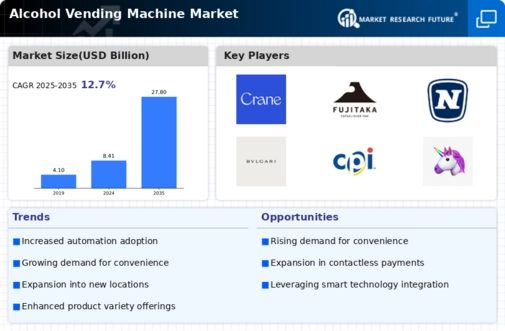Expansion into New Markets
The Global Alcohol Vending Machine Market Industry is poised for expansion into emerging markets, driven by increasing urbanization and changing lifestyles. Countries with growing middle-class populations present lucrative opportunities for alcohol vending solutions. As disposable incomes rise, consumers in these regions are more willing to spend on convenience and quality. For instance, markets in Asia-Pacific are witnessing a surge in demand for alcohol vending machines in urban centers, where traditional retail may not suffice. This expansion is expected to contribute significantly to the projected market growth, reinforcing the industry's global footprint.
Technological Advancements
Technological innovations play a pivotal role in shaping the Global Alcohol Vending Machine Market Industry. Modern vending machines are equipped with advanced features such as cashless payment systems, touchless interfaces, and real-time inventory tracking. These enhancements not only streamline the purchasing process but also improve operational efficiency for vendors. For instance, the integration of artificial intelligence enables personalized recommendations based on consumer preferences. As technology continues to evolve, it is likely that the market will witness an influx of smart vending solutions, further driving growth and enhancing user experience.
Changing Consumer Preferences
Shifts in consumer preferences significantly impact the Global Alcohol Vending Machine Market Industry. Younger generations, particularly millennials and Gen Z, exhibit a preference for unique and diverse beverage options, including craft beers and artisanal spirits. This demographic is more inclined to explore innovative purchasing methods, such as vending machines that offer a curated selection of alcoholic beverages. As these preferences evolve, manufacturers are likely to adapt their offerings to cater to this audience, thereby enhancing market appeal. The anticipated CAGR of 11.47% from 2025 to 2035 underscores the importance of aligning product offerings with consumer trends.
Rising Demand for Convenience
The Global Alcohol Vending Machine Market Industry experiences a notable surge in demand for convenience-driven solutions. As urban lifestyles evolve, consumers increasingly seek quick and easy access to alcoholic beverages. This trend is particularly pronounced in metropolitan areas where busy schedules limit traditional shopping opportunities. The availability of alcohol vending machines in strategic locations such as airports, bars, and entertainment venues caters to this need, enhancing consumer satisfaction. The market is projected to reach 8.41 USD Billion in 2024, indicating a robust growth trajectory as convenience becomes a primary driver for consumer choices.
Regulatory Changes Favoring Vending Solutions
The Global Alcohol Vending Machine Market Industry is influenced by evolving regulatory frameworks that increasingly support the deployment of alcohol vending machines. Governments are recognizing the potential for these machines to provide controlled access to alcoholic beverages, particularly in environments where traditional sales may be restricted. For example, certain jurisdictions have implemented regulations that allow vending machines to operate in designated areas, thereby expanding market opportunities. This regulatory shift not only facilitates compliance but also encourages investment in vending technology, potentially leading to a market valuation of 27.8 USD Billion by 2035.





















Leave a Comment